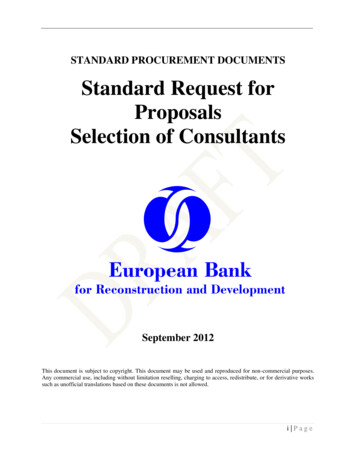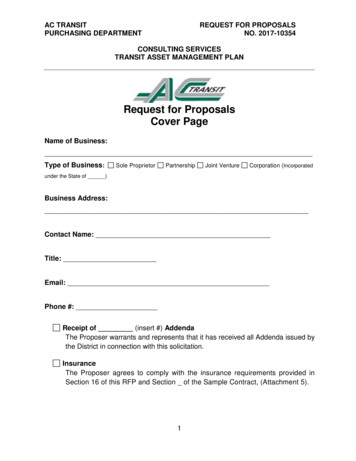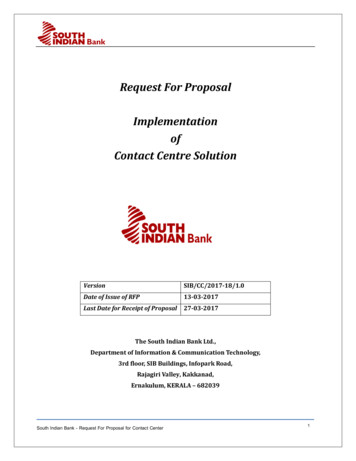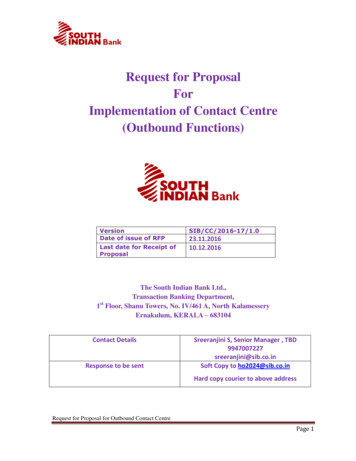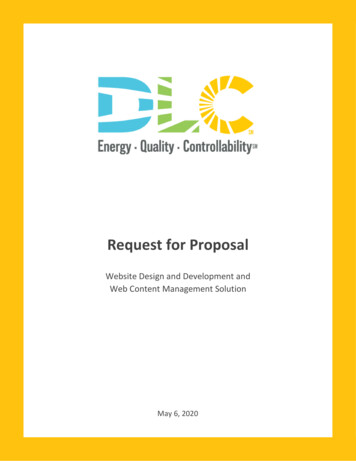
Transcription
Request for ProposalWebsite Design and Development andWeb Content Management SolutionMay 6, 2020
Table of Contents1.0 Introduction . 21.1 DLC Mission . 21.2 DLC Technology Platforms . 21.3 DLC Stakeholders . 31.4 Existing Website . 61.5 RFP Purpose . 71.6 Intent of RFP . 71.7 Preferred Respondent Qualifications . 81.8 Desired Capabilities . 82.0 Scope Overview. 92.1 Task 1: Planning and Website User Story/Profile Development . 92.2 Task 2: Website Redesign . 93.0 Direct Query Questions to RFP Respondents . 114.0: Additional Direct Query Questions: Technical, Architecture, Performance, Security, andHosting Options. 245.0 Instructions to Respondent . 295.1 Timeline. 295.2 RFP Evaluation Criteria . 295.3 Contact . 295.4 Submission of Response . 305.5 RFP Responses Property of the DLC. 306.0 Response . 316.1 Title and Transmittal . 316.2 Executive Summary. 316.3 Statement of Qualifications . 326.4 Narrative Regarding Services . 326.5 Narrative on Tasks . 336.6 Additional Topics for All Respondents . 337.0 Attachments . 347.1 Website Examples . 347.2 Sitemap for the Current Website. 34Request for Proposal:Website Design and Development and Web Content Management Solution1 of 38
1.0 IntroductionThe DesignLights Consortium (DLC ) is a non-profit organization that promotes the use of high-quality, energyefficient lighting and controls products in collaboration with utilities, energy efficiency program members,manufacturers, lighting designers, and federal, state, and local entities. Through these partnerships, the DLCestablishes product quality specifications, facilitates thought leadership, and provides information, education,tools and technical expertise.1.1 DLC MissionThe DLC mission is to achieve energy optimization by enabling interconnected solutions with a focus on qualityfor people and the environment. The DLC drives efficient lighting by defining quality, differentiating productsand delivering tools and resources to the lighting market through open dialogue and collaboration.1.2 DLC Technology PlatformsSolid-State Lighting ProgramThe DLC Solid State Lighting (SSL) Qualified Products List (QPL) is our core program and the leading publicresource for high quality, efficient LED products for the commercial sector. The QPL currently lists nearly 600,000products from more than 2,500 manufacturers in 70 Primary Use Designations. These qualified products meetstrict performance requirements for light output, efficacy, color metrics, and reliability and are referenced byhundreds of rebate and procurement programs throughout the US and Canada. Making these requirements andtheir implications easy for our member utilities, lighting manufacturers, and other stakeholders to locate andunderstand is paramount. Additionally, with over 500 product applications received each month, highly technicalapplication instructions must be accessible and clear for manufacturers of LED lighting products who want todesign qualified products and get their products listed.Networked Lighting Controls ProgramThe DLC’s Networked Lighting Controls (NLC) Technical Requirements are based on control system capabilitiesand have a separate searchable, filterable QPL of control systems that meet these specifications. Additionally,the program contain a set of supporting information, including research that helps validate energy savings, casestudies, and training programs to enable widespread adoption of networked lighting controls in commercialbuildings. The NLC requirements and QPL are quite different from SSL QPL requirements and the NLC section ofthe website must be easily differentiated for NLC QPL users, utility programs, and the controls manufacturerssubmitting applications for listing.Horticultural Lighting ProgramThe DLC’s Horticultural Lighting Program is the most recent addition to the DLC portfolio of programs. It includesa separate set of Technical Requirements specific to products designed to support controlled environmentagriculture (CEA). The program includes its own QPL for Horticultural Lighting (Hort). The program currentlyincludes Technical Requirements and supplemental guides that provide definitions and application guidance forthe rapidly evolving horticultural lighting sector. This may expand to serve as a central resource for energyefficiency information on horticultural lightinge as the emerging science advances. Horticultural products areevaluated using a different set of metrics than traditional LEDs and the QPL has a very different audience ofRequest for Proposal:Website Design and Development and Web Content Management Solution2 of 38
utility end-use customers (growers) and manufacturers in addition to utilities and policy makers, so this sectionmust also be easily accessed and differentiated from the other two technology sections.Future Technology AreasThe DLC is continually evolving as an organization. Therefore, our website must have the capability to beextremely dynamic and allow internal staff to manage content and add large content sections without having toengage a developer each time a change or expansion is needed.The Value and Flexibility of DLC ResourcesThe DLC plays a critical role in advancing adoption of commercial and industrial solid-state lighting (SSL) andcontrols technology by differentiating quality products for utility energy efficiency programs and their end-usersacross the U.S. and Canada. A continually growing and expanding organization, the DLC serves a wide variety ofstakeholders, including utility efficiency program administrators, lighting product manufacturers, lightingdesigners, specifiers, policy makers, and efficiency program end-users, and is continuously reevaluating ourvalue to these and other market actors. Because lighting technology and the energy efficiency landscape changerapidly, the DLC must position itself to quickly pivot to or expand upon new business lines, stakeholder groups,or value propositions that best serve our mission as the industry changes.There are several ways the DLC implements the QPLs and its other resources to effectively enable this growth: Periodically updating Technical Requirements for QPL listing through a collaborative stakeholder inputprocess to meet the needs of utility members and lighting manufacturers; Ensuring that efficacy does not come at the expense of lighting performance by continually updatingthe Technical Requirements and information displayed on QPLs and by providing educational resourcesto our members and the lighting industry; Expanding product categories or program areas to facilitate new product applications for differenttypes of lighting; Phasing out lower-performing and outdated products; Encouraging innovation and identifying market leaders by offering Premium tier QPL listings; and Performing and publishing research studies and distributing the results through our various channels.All of these activities involve the engagement of a variety of stakeholders to communicate proposals of highlytechnical changes, gather feedback through a formal, iterative stakeholder input process, and communicate thenew requirements, resources, and tools to all of these audiences. The website plays a critical role in providingthe landing space for access to all of this information.1.3 DLC StakeholdersUtility and Energy Efficiency Program Administrators (Members)Utility and energy efficiency programs use the DLC resources to identify high-performing, credible products toinclude in their rebate programs. For DLC utility members, the DLC QPLs and requirements are essential forfinding high-performing, highly efficient products, which are critical to the success of any energy efficiencyprogram. The DLC eliminates the administrative hassle associated with vetting individual products—savingprograms significant time, money, and resources. To manufacturers of commercial LED lighting and controlsproducts, the DLC seal of approval and inclusion on the QPL enhances product credibilityand enables access toutility incentive programs.Request for Proposal:Website Design and Development and Web Content Management Solution3 of 38
Utilities and energy efficiency programs pay an annual membership fee to access and use the DLC resources anddata, as well as to influence the development of new tools and existing resources. The DLC makes strategicdecisions on policy and Technical Requirements development based on member needs. For example, newproduct categories are often developed by member request.Value to members include: Qualified Products Lists (QPLs): ready-made lists of high-performing, credible products that member staffcan confidently include in their rebate programs. The QPLs eliminate the administrative hassle associated with vetting individual products—savingsignificant time, money, and resources. Opportunities to collaborate with other industry stakeholders and influence product developmentthrough input on the Technical Requirements and at events such as the annual DLC StakeholderMeeting. Open access to technical experts who are always available to answer questions. Access to cutting-edge thought leadership, insight into innovation and market trends. Practical tools and resources. Latest industry news and events.Commercial/Industrial and Horticultural Lighting and Controls ManufacturersManufacturers apply for product qualification, pay application review fees, and after robust evaluation by theDLC, have their qualifying products listed on the QPLs. Listing on the QPLs provides manufacturers with distinctcompetitive advantages, as the QPLs act as the leading resource for efficiency program administrators todistinguish high performing products and is a go-to resource for procurement agents and government agenciessuch as municipal street lighting projects as well as GSA and FEMP projects.Due to the complexity of DLC product categories and testing required to submit products, it is essential that theDLC website breaks down information clearly for manufacturers, who are often on tight timelines or internaldeadlines to qualify and market their products.Manufacturers are a critical stakeholder group for the DLC and provide input and feedback on the DLC’s policyand Technical Requirements development efforts. This allows the DLC to stay informed about market trends andtechnology developments and develop requirements that manufacturers are capable of meeting.The DLC gives manufacturers a voice in the shaping of efficient lighting specifications and programs. Additionalvalue adds for manufacturers include: Access to the multi-billion-dollar energy efficiency program market. QPL ‘verification of performance’, a clear point of differentiation versus competitors. Opportunities to collaborate with other industry stakeholders and influence the requirementsdevelopment process. Open access to technical experts who are always available to answer questions. Insight and access to utility programs and market trends.Request for Proposal:Website Design and Development and Web Content Management Solution4 of 38
Additional StakeholdersTesting Laboratories:Testing laboratories provide supporting documentation and conduct the testing for manufacturers that isnecessary to apply for DLC qualification. In some cases, laboratories submit applications to the DLC on behalf ofmanufacturers and manage the process for them. With each revision to the SSL or Horticultural TechnicalRequirements to raise the bar on product performance, re-testing of products may be required. The DLC relieson accredited laboratories to test products to accepted industry testing procedures and standards and to reportperformance accurately. Testing laboratories provide valuable feedback on the impacts of DLC policies and arealways encouraged to provide feedback on policy and Technical Requirements development, just likemanufacturers.Lighting Decision Makers:DLC resources are used by this stakeholder group to select lighting products for installation. Lighting decisionmakers include corporate or government procurement officers, lighting designers, specifiers, energy servicecompanies (ESCOs), contractors, and others who may use the DLC label and related test results to selectproducts or verify the performance of a product prior to purchase. Lighting decision makers gain value from ahigh level of trust in the quality of the DLC brand, from easy-to-understand, comprehensive information on theQPL, and the assurance that their customers will be satisfied with the quality of the lighting that gets installed.Important to note is that these stakeholders must know about the DLC’s resources in order to make use of them.Effective communication with these stakeholder groups will put another tool in their arsenal to create efficient,high quality lighting decisions.Growers (for Hort QPL):As the indoor agricultural market is quickly evolving, growers need an objective, third-party list to use for initialproduct selection that presents consistent, relevant product information so that they can make an “apples toapples” comparison. The DLC Horticultural QPL and associated resources also help extension personnel acrossthe US provide technical expertise to growers by allowing them to reference the QPL for objective informationabout horticulture lighting products. The QPL also includes filters that help website users to quickly find lightingproducts that meet energy and building code compliance requirements.End-use customers of lighting and controls products:Indirect stakeholders of the DLC, end-users are the vast quantities of people who live and work under DLCqualified lights. When high quality lighting exists, end-users aren’t aware of it – but when it doesn’t, theirhappiness, productivity, and health are impacted. End-users value lighting that provides a pleasant living andworking environment, but they don’t want to have to advocate for it or take action to make it happen. Endusers are far less frequent visitors to the DLC website, and may not even know that the DLC exists, but they allbenefit from the positive effects of energy efficient, high quality lighting in their living and workingenvironments.Policymakers:The DLC QPLs help policymakers and regulators by providing snapshots of efficient products that can informenergy efficiency measure development and be compared to baseline efficiency to determine energy savings. Byhaving a third party vet the technical reports, policy makers don’t have to become domain experts in lightingand controls jargon and technical evaluation methods. The QPLs also provide accessible lists that helpconstituents find commercial products that comply with their regulations.Request for Proposal:Website Design and Development and Web Content Management Solution5 of 38
1.4 Existing WebsiteThe current DLC website was designed around the SSL QPL and the systems that conveyed information aboutthe SSL Technical Requirements and instructions for listing SSL products. These are still two importantobjectives, but the DLC has expanded to include NLC and Hort lighting, which have different, equally importantrequirements and audiences, and may continue to expand to other program areas in the future Additionally, thewebsite is used by multiple DLC teams to: Communicate the DLC’s mission and mission impactCommunicate complex technical requirements and policies for different technologiesExplain the process to submit product applicationsCommunicate upcoming policy changes and timelines for development workCommunicate news and updates and archive old newsList upcoming events and event informationArchive webinars, tutorials, and other presentionsHouse resources, studies, and research on energy efficiency, the lighting market, etc.Communicate how to use DLC logos and trademarksIssues with Current WebsiteAs the DLC has expanded focus to include NLC and Horticultural QPLs and requirements, pages have been addedwith rich content, but these are not intuitive to access from the homepage. Each technology page follows thesame structure (SSL, Hort & NLC), but there is little overlap between technologies and their requirements, whichmakes navigation confusing for submitters and other website users.The homepage of the current website also contains a lot of real estate that is not effectively used. Much of theinformation website users need to navigate to the correct section of the website appears below the fold andthey must scroll to find it.SSL applications make up the vast majority of revenue for the DLC, but instructions for submitting an applicationrequires multiple clicks to discover, and are contained in numerous pages throughout the Solid-State Lightingsection. Information is not organized in a way that is easy for different website users to navigate. Information isvery technical and text-heavy, requiring users to spend time trying to find the information they want or contactprogram staff or contractors to get what they need. Applications are processed in a separate application portal(the AMS, or application management system) but policies and instructions are located on the “Submit aProduct” web page, located under the SSL tab, with a sidebar to help navigate to the correct content page. It isnot clear to submitters how to get from the main page to these requirements pages, or to the AMS. While theinformation has been refined and simplified to be easier to find, the navigation is still cumbersome andinterferes with DLC’s efforts to be transparent. Left hand navigation menus are also poorly designed and containfar too many items to be useful.Current Efforts pages were added to the website to provide up-to-date information on development activitiesbut navigating to the Current Efforts section and to the individual sub-pages is not intuitive. Multiple graphicshave been added to the content to break up text and help guide website users to sub-pages and technicalrequirements and proposal documents, but is still text-heavy and requires significant effort to update.The News & Events main page provides an archive of all announcements, webinars and news but is extremelybusy, appears below the fold, and does not engage website users. The Resources header on the main menuprovides a catch-all for everything that is left over (Blog, research reports, Member summaries, LogoCompliance) but does not have its landing page where these items are displayed and accessed.Request for Proposal:Website Design and Development and Web Content Management Solution6 of 38
Based on feedback that some stakeholders do not clearly understand the mission and goals of the DLC, theAbout Us section has been expanded to include information about staff, the Board of Directors, IndustryAdvisory Committee, Membership, History, and new in 2019, Annual Reports. While these additions make theinformation available to website users, the About Us section is not proactively engaging them and lacks a focuson the broadscale impact of our work.Finally, the current DLC website was designed to be mobile-responsive, but navigating the website and the QPLson a phone screen is extremely difficult and unintuitive. Not all features of the website current work on mobile.At a high level, the current website design does not inspire interaction from users. It is organized by technologyarea rather than audience/user needs, with emphasis on the SSL QPL. There is a lot of information, but it is nottargeted to specific audiences, and there are many layers to click through to find needed content.Internally, the CMS (Mura) contains many quirks and kinks that require workarounds from DLC staff who aretrying to update and add website content. The DLC also cannot make major structural changes or add design orfunctional elements to the website without significant web development, which does not serve our constantlyevolving information and content.1.5 RFP PurposeThe purpose of this RFP is for the DLC to solicit interested and qualified potential website redesign, developmentand Web Content Management solution Vendors to redesign the DLC website in 2020 to provide a betterwebsite user experience for each stakeholder group and easier website maintenance for the DLC.Website redesign objectives are: Provide a fresh, modern, clean new website design Create a more engaging, informative, and educational channel for all audiences to connect with the DLCplatforms, programs, and activities. This may include video or animations or the means to host video oranimations on the website Design intuitive navigation to relevant content for each audience’s needs so that they spend less timetrying to find information Simplify the way that content is displayed so that it is easy to understand and clearly conveys value Enable nimble content management by providing ready-made templates that can be easily modified byinternal DLC staff Provide design that is optimized to be viewed on any computer or mobile device Create a framework that can integrate new tools in the future, such as dashboards to display QPLstatistics and data visualization for website users, a tutorial platform for educating these users, andadditional feedback channels for them to interact with the DLCThe DLC encourages respondents to submit proposals for design and development services that meet the abovecriteria as well as suggestions for additional enhancements that meet the DLC objectives for communicationwith our varied audiences.1.6 Intent of RFPProspective website design, development, Web Content Management System vendors (“Respondents”) arestrongly encouraged to respond to this RFP.Request for Proposal:Website Design and Development and Web Content Management Solution7 of 38
This is a solicitation for proposals. A contract award may result from this RFP. The DLC may contactRespondents, at its sole discretion, for additional information following the RFP, including productdemonstrations, presentations, or interviews. The DLC shall not be obligated to contact any Respondent, topurchase goods or services related to this RFP from any Respondent, or to use the content of any response in afuture RFP.The DLC anticipates scheduling presentations with Respondents that meet a reasonable level of responsivenessto the RFP and offer products and services consistent with the scope to obtain further insight. However, the DLCis not obligated to hold vendor presentations or to conduct meetings with all vendors who respond.Response to this RFP is NOT mandatory to be considered for any future solicitation for any services. It is entirelythe Respondent’s responsibility to remain informed of the DLC’s issuance of any future solicitations. The DLCassumes no liability for the failure of Respondents to obtain and respond to any such solicitation.1.7 Preferred Respondent QualificationsA single firm or a team of firms under a single primary Vendor may submit bids to this RFP. Successful Vendorshould have a minimum of five years of experience and project teams should show proficiency in at least thefollowing areas:1.Key staff members must have demonstrated expertise in website design/redesign with a focus on userexperience (UX) and navigation of technical content2.Experience with multiple platform integrations and automation3.Content strategy development and content personalization experience4.Multiple Web Content Management System proficiencyChanges in proposed key staff members may not be made during the execution of the work without the writtenapproval of the DLC.1.8 Desired Capabilities1. Full-service web design firm with an in-house design team, including UX and digital marketing expertise.2. Standard Support. Vendor shall have a support team accessible to the DLC 9am -5pm Eastern StandardTime to address functionality or design-related questions and also to report bugs and address timely bugresolution.3. Training/Documentation. Vendor should be able to provide detailed documentation on every aspect ofsystem functionality available to the DLC and should be able to train DLC staff on functionality within thecontract.4. Custom Support/maintenance.a. Vendor should be able to execute on a content migration project by providing staffing to performrequirements analysis, documentation, coding/scripting as necessary, and testing and projectmanagement capabilities to migrate from the current DLC system to the new system.b. Vendor should be able to make minor customizations to the WCMS platform based on DLC needs.5. Analytics capabilities. The web design should support advanced analytics capabilities that allow the DLCto run complex queries on website activity using Google Analytics and other measurement techniques.Request for Proposal:Website Design and Development and Web Content Management Solution8 of 38
2.0 Scope OverviewVendor shall, in a timely and responsive manner, provide website design and development services to redesign theexisting DLC website with an emphasis on website user engagement, clean design, and intuitive navigation toprovide easier access to relevant content packaged for specific audiences. This work will not include changes to thefunctionality of QPLs or AMS, but will include refreshing any page background design and integration of theseitems with the overall design. Expected timing for launch of the new website is between six and nine months fromaward of contract.While the information in this section of the RFP is being provided to assist potential bidders, bidders are requestedto propose their approach to meeting the project objectives, including their recommendations with respect toappropriate user research, design, development tasks and milestones, the schedule, budget, and possibly modifiedor additional tasks, given the project objectives. The DLC reserves the right to alter the Work Scope andDeliverables based on discussions with the Vendor.2.1 Task 1: Planning and Website User Story/Profile DevelopmentThe redesign of the DLC website is focused on creating specific experiences for the different stakeholder groupsnoted in section 1.3 above, and UX/UI will play a significant role in this project. Utilizing stakeholder researchsurveys conducted by the DLC and market research and user profiles created for DLC by Cadmus Group, theVendor shall define and confirm the needs of each audience and establish design goals for each group.Other planning activities include a review of current website content areas, structure and organization, contentmanagement system (CMS) platform recommendations, hosting considerations, documentation of page designand template needs, etc.2.2 Task 2: Website RedesignThe DLC requires a design for the website that is intuitive, clean, clear, and engaging, and that supports theefforts and mission of the organization. The home page needs a modern look and easy-to-navigate redesign.This design should provide clear direction to find content based on each website user group’s needs withoutlo
Request for Proposal Website Design and Development and . Web Content Management Solution . May 6, 2020 . 1 of 38 Request for Proposal: Website Design and Development and Web Content Management Solution Table of Contents . 2.2 Task 2: Website Redesign .







